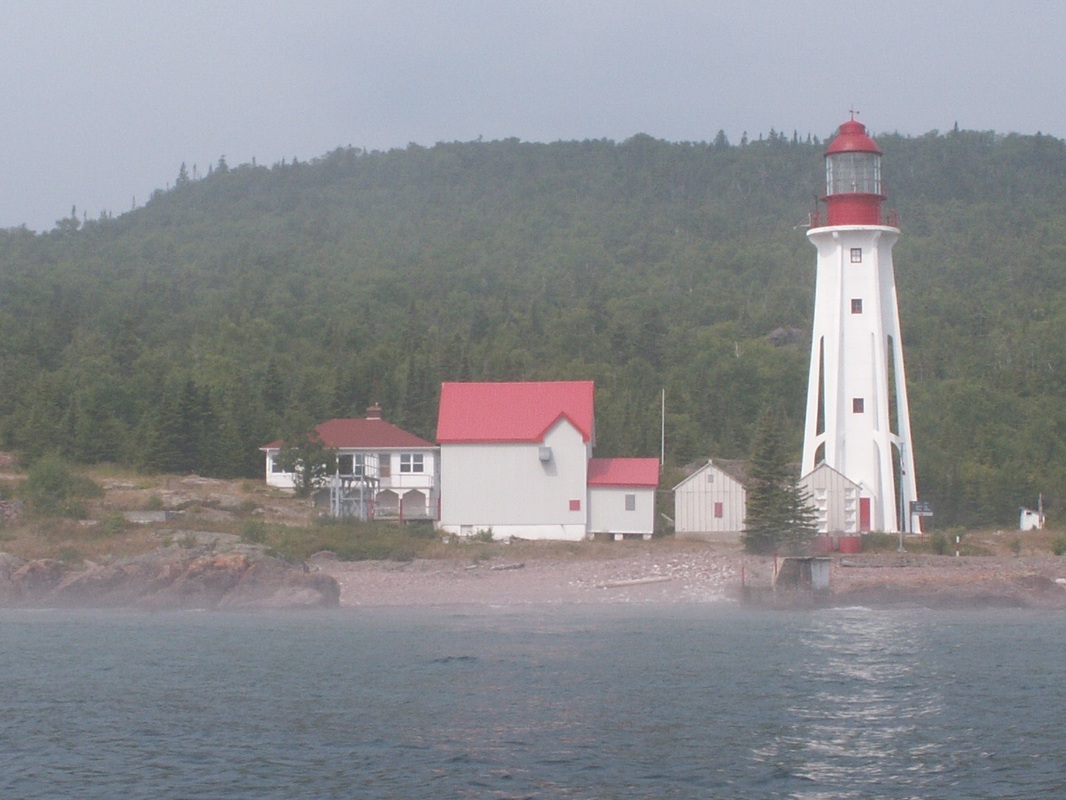The Government of Canada commissioned the construction of lighthouses to guide the growing number of Captain’s plying the unpredictable Superior coastline. The first lighthouse on Lake Superior was built at Quebec Harbour on the south shore of Michipicoten Island in 1872. In 1886, the most remote lighthouse on the entire Great Lakes was constructed on a tiny island next to Caribou Island, 48 kilometres south of Quebec Harbour and 104 kilometres southwest of the nearest shipping port at Michipicoten Harbour. In 1889 a small lighthouse was built to guide fishing vessels and vacationers to the sheltered docks of Gargantua Harbour. The ore boats and passenger steamers welcomed the wooden lighthouse at Perkwakwia Point near Michipicoten Harbour in 1902.
Navigation upgrades to the active shipping lanes along the eastern shoreline meant a new light station at Caribou in 1911, a similar lighthouse tower on the East End of Michipicoten Island in 1912 and a new light standard and lighthouse in Quebec Harbour and nearby Davieux Island in 1918.
The men and women who were given the responsibility of maintaining these beacons of light and safe haven were both resilient and resourceful. Three generations of the Davieux family manned the Quebec Harbour and Davieux Island lights on Michipicoten Island. For almost 6 decades, three generations of the Miron family were keepers of the tiny Gargantua light at the entrance to Gargantua Harbour.
William Sherlock was the first keeper at the Michipicoten Island East End light from 1912 to 1923. He made headlines in 1913 when he decided that he and his family would not return to Sault Ste. Marie in December to wait out the winter season. His frugal reasoning saved him the cost of city rent and was no doubt safer than taking passage on Superior during the most unpredictable time of the year. William’s name made it to print again in December of 1916 when The Sault Star described the harrowing journey made by William and his son at the end of the shipping season. Caught in a sub-zero northeasterly storm, the 45 km trip from Michipicoten Island to Gargantua Harbour took over a week, half of which was spent in their 18 foot boat in the open water, and the other half was spent walking in the snow from Sand River to Gargantua.
William Sherlock’s final headline took place in December of 1918 when George Johnston, the lightkeeper at the nearby Caribou Light telegraphed the Department of Marine in Ottawa that William had not showed up on the mainland at the end of the shipping season. Neither William nor his boat were ever recovered. William’s wife and two children assumed responsibility for maintaining the East End Light until 1923.
In 1915, the Canadian government advised all lighthouse keepers that due to cost-cutting measures, employees and their families would no longer be transported to and from their points of charge at the beginning and ending of the shipping season. Many felt that this bureaucratic decision sealed the fate of William Sherlock and feared that more Superior light keepers would meet the same end. George Johnston and his assistant at the Caribou Island light waited 10 days after the end of the shipping season on December 15, 1919 before a break in the weather finally allowed them to set sail for Quebec Harbour. Ice formations and a winter storm held them fast in the Harbour and then on Michipicoten Bay for 8 days until they finally reached the mainland on New Year’s Day.
In 1921, Ottawa finally relented and commissioned the Canadian Government Ship Lambton to transport all the lighthouse keepers and their supplies to and from their lights. In mid-April 1922 the Lambton set sail from Sault Ste. Marie during a late winter storm and delivered the Miron family and their supplies at Gargantua Harbour. On April 19 the Lambton left the shelter of the small fishing station heading north and was never seen again. As the shipping season commenced, vessels navigating the east shore reported that none of the lighthouses north of Gargantua were operating. Somewhere between Gargantua and Caribou Island on April 19, 1922, the CGS Lambton sank with all 22 passengers on board including George Penefold who was George Johnston`s replacement keeper for the Caribou Island Light, and William Reid, keeper of the Michipicoten Harbour light since 1915.
Many of the lighthouses and the keeper`s dwellings have been torn down. The Gargantua lighthouse was washed away in November 1940. The Michipicoten Harbour light house was the last to be automated on the Ontario shoreline in 1991. The Davieaux Island light continues to shine. The Caribou Island and Michipicoten East End Light are the only 3 active flying-buttress style lighthouses remaining out of 6 built across Canada in the early 1900`s. In 2011 the remote Caribou Island lighthouse celebrates a century of safely guiding ship`s Captains through the unpredictable Superior waters.

 RSS Feed
RSS Feed
